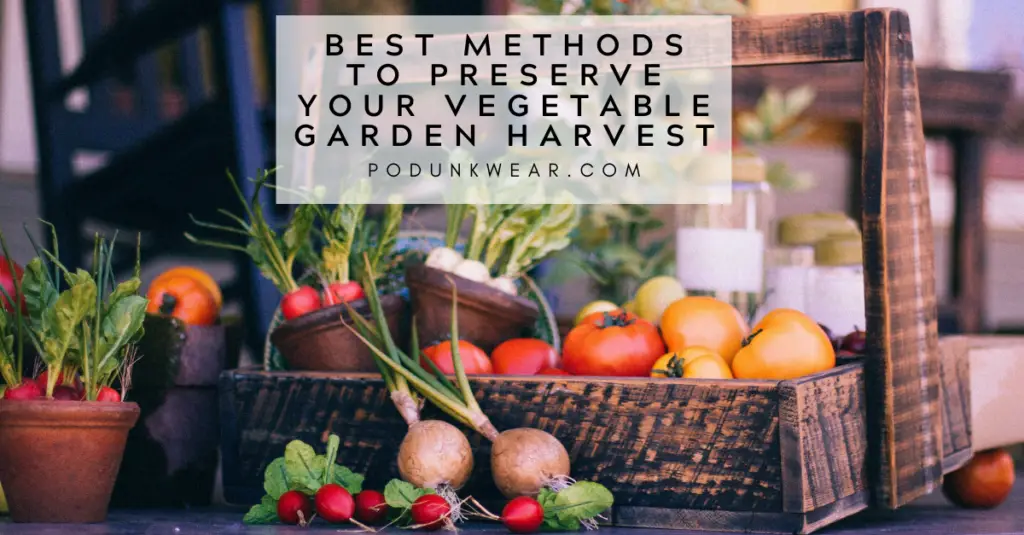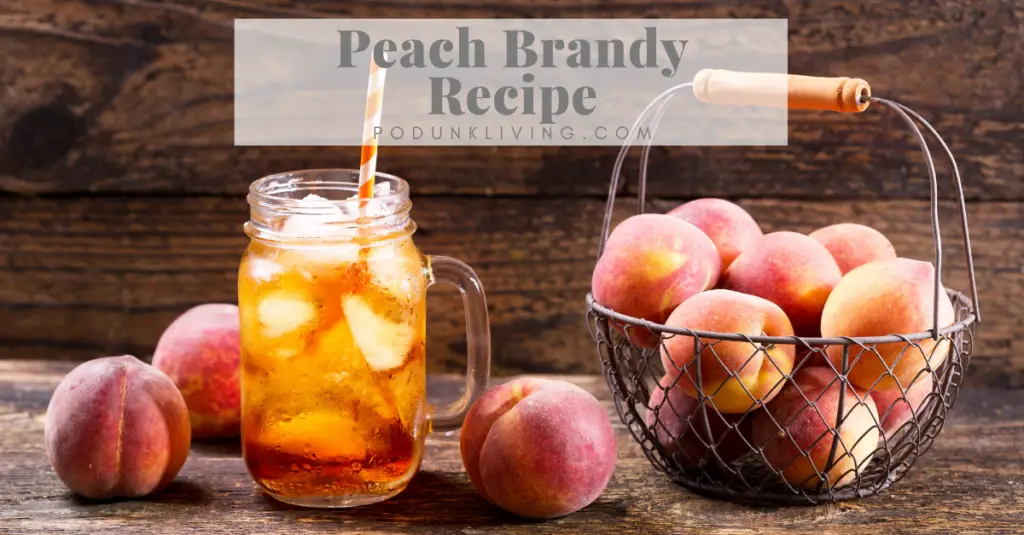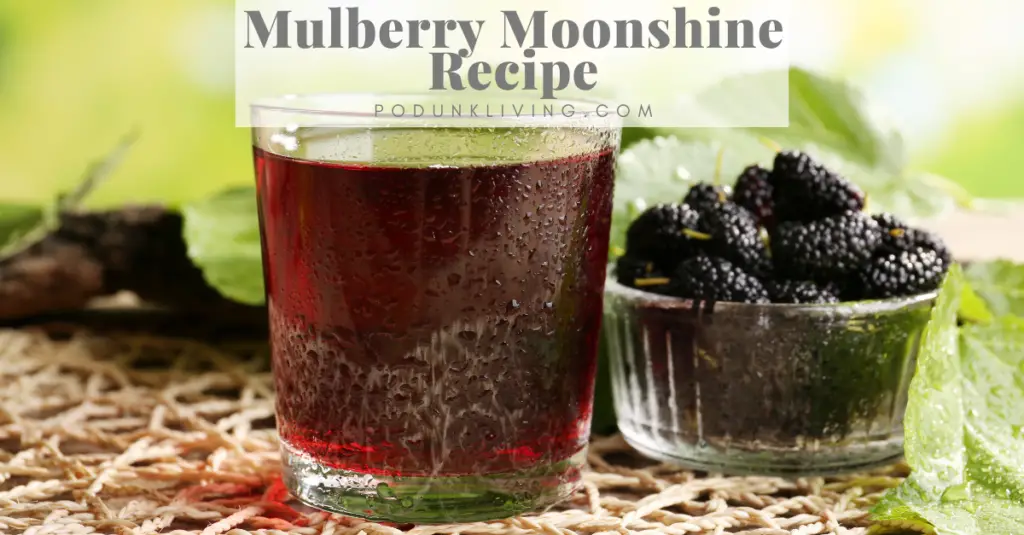The Food and Agriculture Organization estimated that 32% (weight basis) of all food produced in the world was lost or wasted in 2009. For those that have a vegetable garden, it is very hard to see your garden’s harvest go to waste. One of the easiest preservation methods of your home garden harvest is freezing foods. Rhubarb, petite peas, sweet corn, and green beans are easy to blanch and freeze (and taste great when thawed). Just purchase some freezer bags, throw in your harvest, and pop it in the freezer. Another easy way to preserve your bounty is canning. Depending on the fruit or vegetable, your food preservation method may be water bath canning or pressure canning.
Depending on the fruit or vegetable crops, food preservation may or may not be needed for long-term storage. With proper storage, the shelf life of fresh vegetables and fruits may last long into the winter months. The different storage methods allow for staggering of time-consuming food preservation, and with a little organization, you can keep your favorite foods from harvest season until the next year.
Refrigerate these foods from your garden harvest:
- Pears: Unripe pears can be kept in the refrigerator for a few days. In order to let them ripen and develop a better flavor and texture, move them out of the fridge a few days before you plan to eat them. Keep them in a paper bag or perforated plastic bag on the counter. Ripe pears have a shelf life of about 5 seconds, so eat them or water bath can them quickly. Harvest before they are ripe, allow to ripen for about 2 weeks before canning. Read more about the best ways to preserve pears.
- Berries (Strawberries, Raspberries, Blackberries, Blueberries): Never rinse before storage. It washes off the thin, protective epidermal layer. Berries are highly perishable and don’t store for long. If you must store them, place on a paper towel in a tightly-covered container and store in the refrigerator for 2 to 3 days.
- Beans (snap): Keep snap beans such as green beans in a perforated produce bag in the refrigerator and they should keep for about a week. Note that their condition will deteriorate faster if they are kept below 40°F.
- Stone Fruit (Peaches, Cherries, Nectarines, Apricots, Plums): Store stone fruit in perforated plastic bags in the refrigerator. In cold, humid conditions, they’ll keep for 1 to 2 weeks.
- Asparagus: Store asparagus by placing the spears upright in an open container (such as a drinking glass or a jar) that contains about an inch of water. Cover the asparagus loosely with a produce bag. It should keep for 10 to 14 days.
- Broccoli: Store broccoli in a perforated plastic bag in the refrigerator for up to 2 weeks. Do not wash it prior to putting it in the fridge, as this can encourage bacterial rot.
- Herbs: Dill and parsley will keep for about two weeks with stems immersed in a glass of water (like a bouquet of flowers) tented with a plastic bag. Most other herbs (and greens) will keep for short periods unwashed and refrigerated in tightly sealed plastic bags with just enough moisture to prevent wilting. Some fresh woody herbs (rosemary, thyme, chives, sage, oregano) can be stored in a fridge, loosely wrapped in a damp paper towel.
- Carrots, Beets, Turnips, and Parsnips: Carrots, parsnips, beets, turnips, and other root crops should either be stored in a root cellar (if you have one) or in a refrigerator properly for 2 to 3 weeks.
- Grapes: Grapes will keep for 2 to 3 weeks when kept in a perforated plastic bag (like the kind they’re typically bought in) in the refrigerator.
- Muskmelons (Cantaloupe, Honeydew): Muskmelons can be stored whole in the refrigerator for 2 to 3 weeks. Wash them before storage to clean off any debris or bacteria, but let their rind dry before moving them to the fridge. Outside of the refrigerator, they can be kept in a cool part of the kitchen for a week or so.
- Cauliflower: As with broccoli, store cauliflower in a perforated plastic bag in the refrigerator. Do not wash it prior to storage; it should keep for 2 to 3 weeks.
- Citrus (Oranges, Grapefruit, Lemons): Citruses such as oranges, lemons, clementine, and grapefruit can be stored in the refrigerator in a perforated bag or the produce drawer for 2 to 6 weeks.
- Radishes: Radishes keep well in cold conditions. Store in a perforated plastic bag in the refrigerator for up to a month.
- Brussels sprouts: Store sprouts in a perforated plastic bag in the refrigerator for up to a month.
- Cabbage: Cabbage can be stored in the refrigerator in the produce drawer for up to 4 to 5 months..
- Apples: Apples keep well for about 6 months at temperatures between freezing and 45°F. If you don’t have a root cellar, a double cardboard box in a cool mudroom or cellar can approximate the conditions. Remember to give apples an occasional change of air.
Do not store these in the refrigerator
Some vegetables are susceptible to cold damage at temperatures below 40°F, which means that they are best stored outside of the fridge. If possible, keep them in a cool (55°F) part of the kitchen, pantry, root cellar, or mudroom.
- Tropical Fruit (Bananas, Avocado, Pineapple): Store bananas, avocados, and pineapples at about 50°F outside the fridge. Once ripe, they will last 3 to 5 days. (Refrigerating may prolong the ripening process, but can affect taste.)
- Watermelon: Keep watermelon in a cool area 50° F for up to a week.
- Tomatoes: Store tomatoes in a cool spot out of direct sunlight for 5 to 7 days. If still green, they will take 25 to 28 days to ripen at 55°F; at 65°F to 70°F, they will take 14 days. Refrigerating tomatoes ruins their taste!
- Cucumbers: Cucumbers can be stored in the refrigerator for a few days, but will keep for longer in a cool spot in the kitchen. Keep them in a perforated plastic bag for 7 to 10 days. If you are planning on making pickles, harvest the morning of canning for best results.
- Eggplant: Eggplant stores best outside of the refrigerator in a cool part of the kitchen. Under cold conditions, it may develop brown spots after more than a few days. Keep it in a perforated plastic bag for adequate humidity. Eggplant will keep for 7 to 10 days.
- Peppers: Bell peppers can be stored in perforated produce bags in a cool part of the kitchen. They will keep for 10 to 14 days.
- Summer Squash (Zucchini): Zucchini and other summer squashes may be stored in the refrigerator for a few days. For longer than that, store them in a cool part of the kitchen in a perforated plastic bag. They should keep for 10 to 14 days.
- Pumpkins and Winter Squash (Butternut, Acorn): Squashes don’t like to be quite as cool nor as humid as root crops do. Store squash in a place with a temperature of about 50° to 65°F. Below 50°F, they are subject to chilling damage. Above 65°F, they become stringy. They’ll keep for about 2 to 3 months.
- Potatoes: cooling potatoes will turn their starch to sugar. Simply brush off any soil, and store in a dark, cool place that is about 40°F (4.5°C). Store in the basement, in a cold dark area, for 6 months.
- Don’t store potatoes with onions or apples; these crops give off ethylene gas that will spoil the potatoes.
- Onions, Garlic, and Shallots: Never put onions nor garlic (nor shallots) in the refrigerator. Store them in a dry, cool (40 to 50°F), ventilated place. It’s best to store them in mesh bags (which they often come in) to get that ventilation. Onions ang garlic can keep 6 months or more. I braid and hang mine, and it usually lasts for a year.
- Do not store onions near potatoes! They are not friends. Potatoes excrete moisture and speed up onion decay.
- Green onions and scalions can go in the fridge.
Commercial Preservation Methods:
heat treatment:
Blanching certain fruits and vegetables (or a hot water rinse) for 30 seconds to 3 minutes in 98° to 131° water has been shown to preserve shelf life. This is due to the reduction of bacteria and fungi on fresh fruits and vegetables. One study on whole canteloupe and plums has shown an increase in skin firmness while decreasing the amount of moisture loss. Another study of low-level heat treatment of fish extended refrigerated shelf life by 1.5 days (extending from 9 days to 10.5). There are also reports of quality improvements in bell peppers, apples, melons, sweet corn, kumquats, and grapefruits after a hot water rinse. Hot water treatments have also been shown to delay ripening and reduce chilling injury in potatoes, tomatoes, carrots, strawberries, asparagus, broccoli, beans, kiwi, celery, lettuce, melons, grapes, plums, peaches, and spinach. So far, the foods that do not benefit from hot water treatments (or blanching) include asparagus, nectarines, and leafy vegetables.
edible coating:
Edible coatings provide a partial barrier that minimizes moisture loss and preserves the food’s color and texture. Foods that often have an edible coating applied include apples, pears, carrots, celery, strawberries, and mushrooms. Materials for edible coatings include guar gum, pea starch, potato starch, potassium sorbate, candelilla wax, soya bean gum, jojoba wax, glycerol, Arabic gum, aloe vera gel, beeswax, coconut oil, sunflower oil, chitosan (from shellfish), acetic acid, whey protein, and rice bran oil.
irradiation:
Irradiation slows the speed at which enzymes change the food, and kills microorganisms (both pathogenic and beneficial) and pests that can affect food quality and shelf life. Foods that often undergo irradiation to preserve shelf life: potato, onion, strawberry, and mango
antimicrobial and anti-browning agents:
Antimicrobial and anti-browning agents offer the possibility to maintain safety and can be grouped into chemical, natural, or biological-based agents. Chemical-based agents include chlorine-based solutions, peroxyacetic acid (PAA), organic acids, hydrogen peroxide (H2O2), and electrolysed water. A chlorine-based solution has been one of the commonly used disinfectants for fresh produce, which is most cost-effective. This additive slows browning, deterioration of texture, and microbial growth. Foods that commonly have anti-browning and antimicrobial agents include apple, strawberry, lettuce, melon, orange, prune, tomato, grapes, and fresh-cut produce.
Nitric oxide:
Nitric oxide is applied to food to reduce ethylene gas production, reduce water loss, slow browning, and lower the incidence of postharvest diseases. Chronic inhaled exposure to nitric oxide has been shown to cause respiratory issues and infertility. Skin absorption of nitric oxide has been shown to be toxic, and requires medical attention immediately whether symptoms appear or not. The need for intubation (breathing tube) may suddenly or unexpectedly be needed with over-exposure to nitric oxide. Foods commonly treated with nitric oxide: apple, banana, kiwifruit, mango, peach, pear, plum, strawberry, tomato, papaya, loquat, jujube fruit, and bayberry.
Sulfur Dioxoide
Sulfur dioxide is applied to food to prevent postharvest decay. Foods that often contain sulfur dioxide include: grapes, litchi, fig, banana, lemon, apple, and blueberries. Sulfur dioxide is also contained in many beverages including alcoholic beverages, and many dried fruits. In 1980, a study showed that 1 of 9 with asthma reported symptoms worsening when drinking soft drinks containing sulfur dioxide.
ozone:
Ozone does not act as a systemic poison to microorganisms, but rather, destroys them through the process of oxidation. Ozone gas is harmful when a person inhales it, leading to lung and throat irritation, coughing, and worsened asthma symptoms. High exposure can lead to lung damage and can be fatal. However, ozone therapy has also been used to treat arthritis, ischemic heart disease, macular degeneration, cancer, and fighting viruses like HIV and SARS. Foods often treated with ozone include apples, cherries, carrots, garlic, kiwi, onions, peaches, plums, potatoes, and grapes.
1-Methylcyclopropene:
Methylcyclprepene (SmartFresh™) is a chemical-based ethylene gas inhibitor. It extends shelf life by 3-6 days, but can increase susceptibility to CO2 injury and chilling disorders. Foods often treated with methylcyclprepene include apples, avocados, bananas, broccoli, cucumbers, dates, kiwifruit, mangos, melons, nectarines, papayas, peaches, pears, peppers, persimmons, pineapples, plantains, plums, squash, and tomatoes.
Controlled atmosphere storage:
Controlled atmosphere storage is a sealed room with reduced oxygen levels, temperature control of 32-36 degrees Fahrenheit, and controlled humidity levels. Room air oxygen levels are normally at 21%, in controlled atmosphere storage, it is often reduced to 1-2%. Controlled atmosphere storage slows decay, however, extended storage periods are needed to make investment economical. Foods often kept in controlled atmosphere storage include apples, pears, avocados, strawberries, cherries, cabbages, kiwifruit, persimmons, pomegranates, asparagus, bananas, broccoli, cranberries, mangos, melons, nectarines, peaches, and plums.
Modified atmosphere packaging:
Modified Atmosphere Packaging creates an optimal environment to extend produce shelf life. The specifically engineered micro-perforations control gas flow in and out of the package. This flow manages the oxygen and carbon dioxide levels inside the package and matches that flow to the food’s respiration rates. Oxygen flow into the package is reduced, slowing the ripening process and conserving moisture. The excess CO2 that is produced by the fresh produce is also able to diffuse. The controlled rate of exchange promoted by the MAP packaging allows the internal atmosphere of the package to reach an oxygen level lower than the regular air. Store-bought foods that come with modified atmosphere packaging include strawberries, bananas, cherries, carrots, fresh-cut fruits, salad mixes, and leafy green vegetables.
If you are interested in learning more about the chemicals applied to store-bought foods, read this article.
- Sources:
- https://www.ncbi.nlm.nih.gov/pmc/articles/PMC4006172/
- https://pubag.nal.usda.gov/download/1713/PDF
- https://www.almanac.com/how-store-vegetables-and-fruit
- https://pubmed.ncbi.nlm.nih.gov/7426352/





